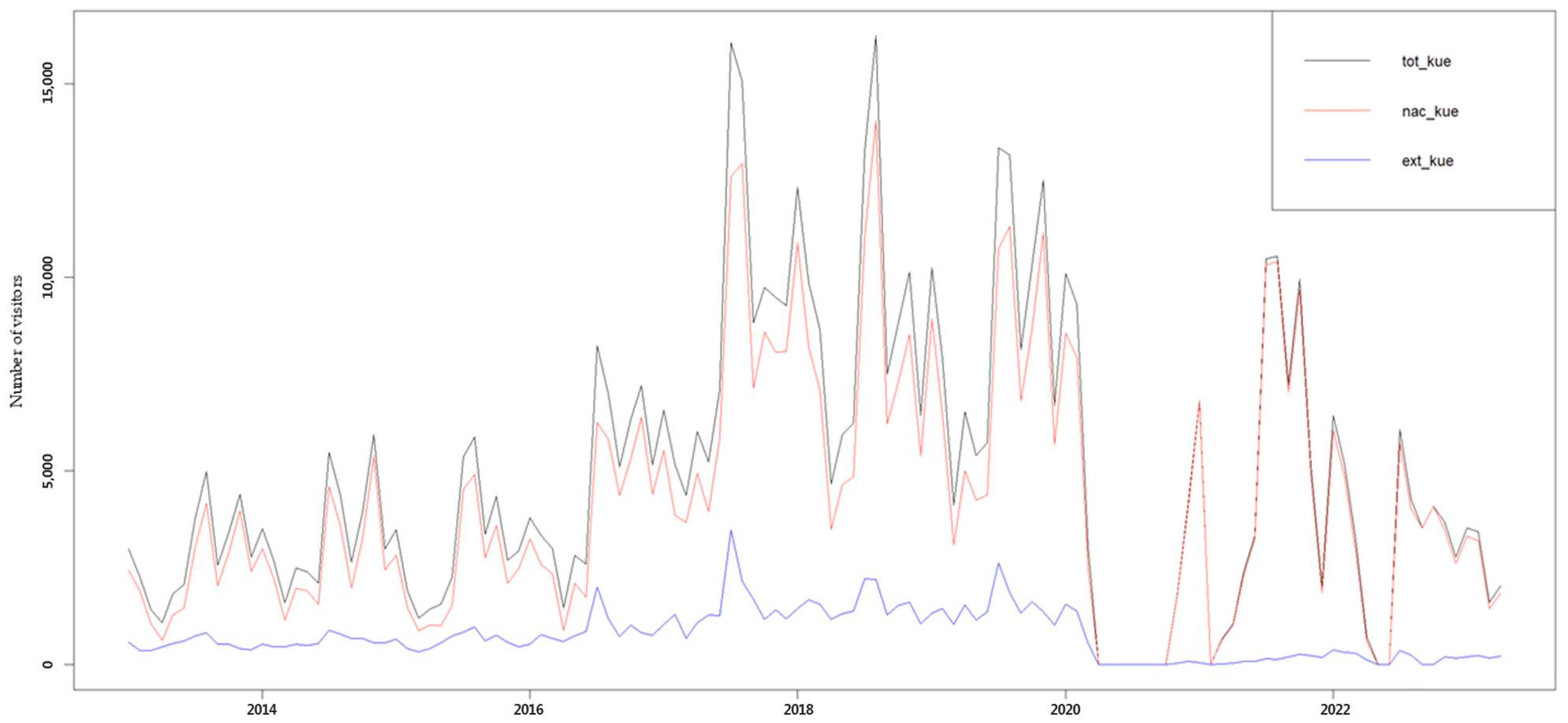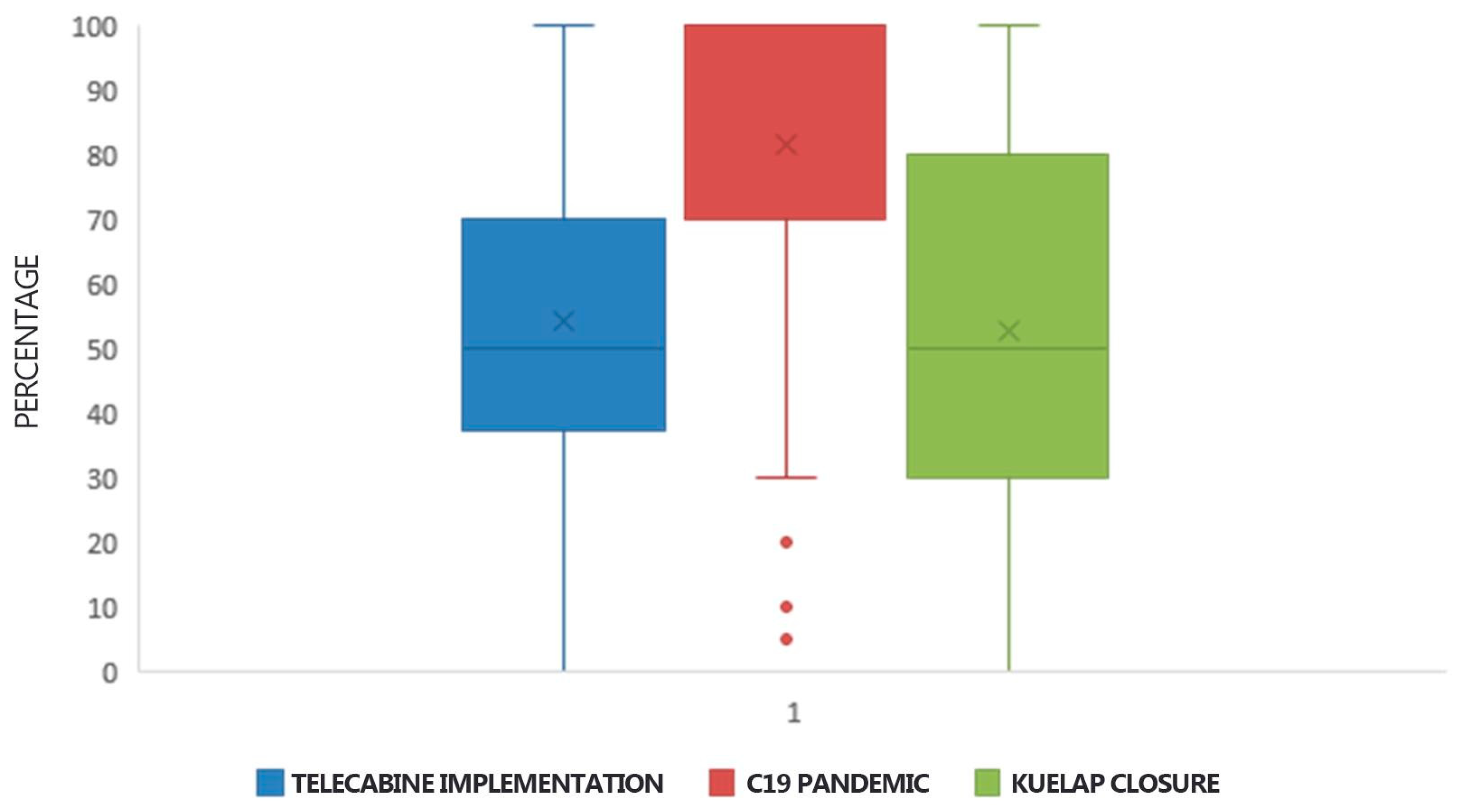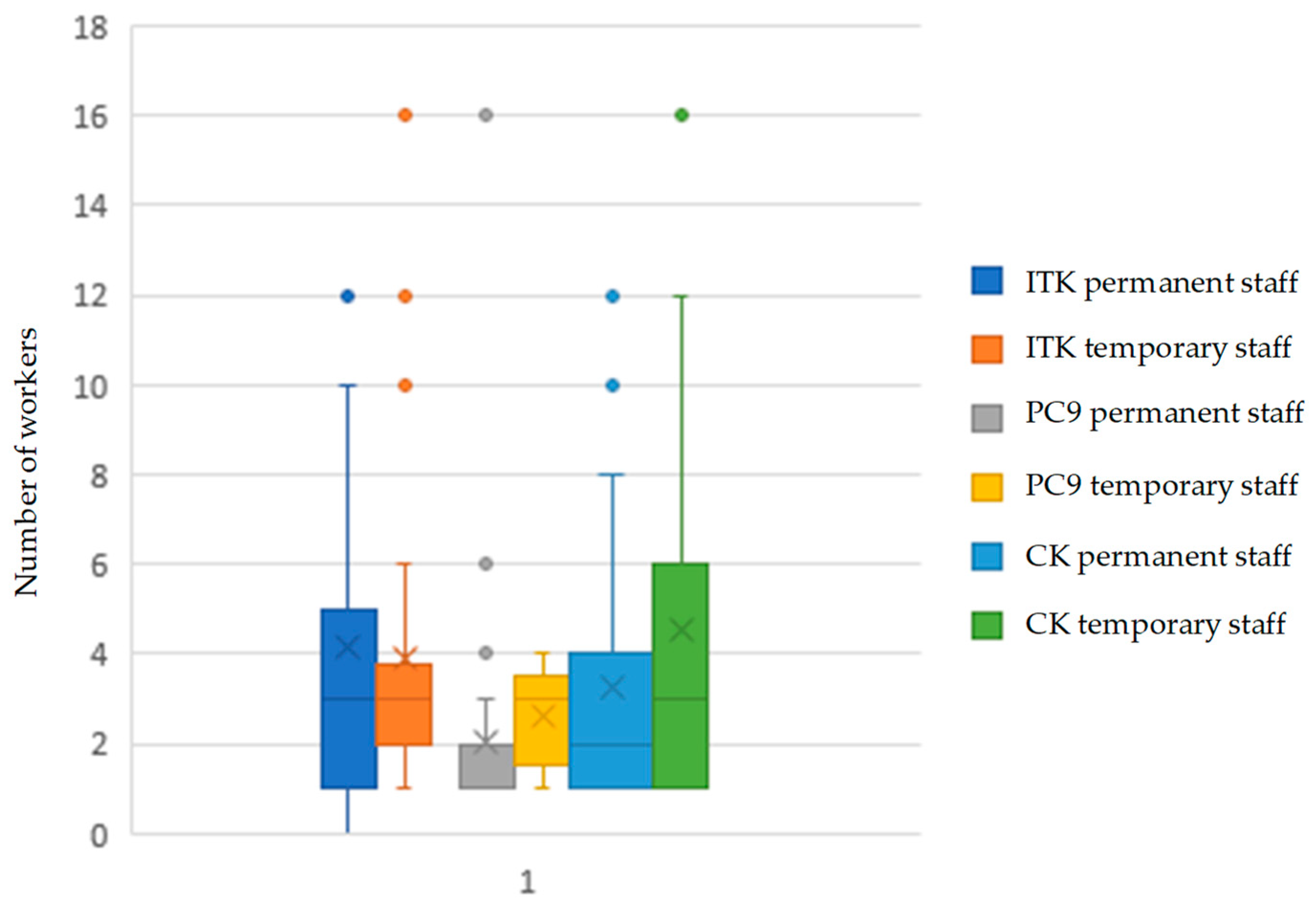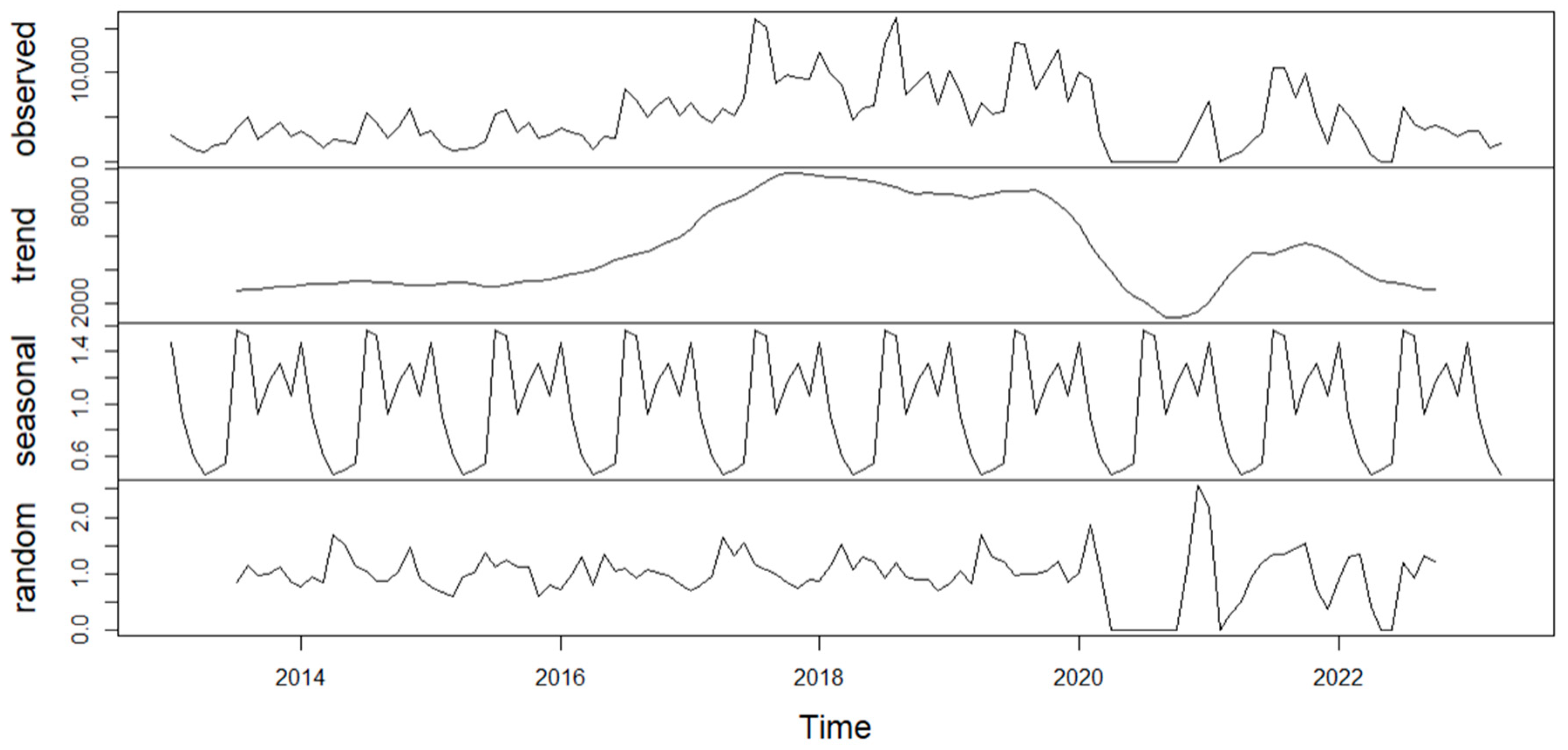A Structural Analysis of the Economic Impact of Tourism and the Perspective of Tourism Providers in Kuélap, Peru
Abstract
1. Introduction
2. Variables under Study
2.1. The Structural Economic Impact of Visits
2.2. Perception of Providers among Kuélap Tourists
3. Materials and Methods
3.1. Kuélap Monumental Archaeological Zone
3.2. Offer: Perceptions of the Offer
3.3. Demand from the Sector: Analysis of the Structural Break and Effects of the Visits to Kuélap
4. Results
4.1. Results of the Perceptions of Offers
4.2. Results about Visits to the Kuélap Archaeological Site
4.3. Estimation of the Effects of the Implementation of Cable Cars, the COVID-19 Pandemic and the Closure of Kuélap on Visits to the Kuélap Archaeological Site
5. Discussion
6. Conclusions
Author Contributions
Funding
Data Availability Statement
Conflicts of Interest
References
- Sharma, A.; Kukreja, S.; Sharma, A. Role of tourism in social and economic development of society. Int. J. Adv. Res. Manag. Soc. Sci. 2012, 1, 10–31. [Google Scholar]
- Mihalič, T. Economic impacts of tourism, particularly its potential contribution to economic development. In Handbook of Tourism Economics: Analysis, New Applications and Case Studies; World Scientific: Singapore, 2013; pp. 645–682. [Google Scholar]
- Bunghez, C.L. The importance of tourism to a destination’s economy. J. East. Eur. Res. Bus. Econ. 2016, 2016, 143495. [Google Scholar] [CrossRef]
- Habibi, F.; Rahmati, M.; Karimi, A. Contribution of tourism to economic growth in Iran’s Provinces: GDM approach. Future Bus. J. 2018, 4, 261–271. [Google Scholar] [CrossRef]
- Jamel, L. The relation between tourism and economic growth: A case of Saudi Arabia as an emerging tourism destination. Virtual Econ. 2020, 3, 29–47. [Google Scholar] [CrossRef] [PubMed]
- Chanquey, Y.; Lagos, N.; Llanco, C. Análisis del crecimiento económico en función del turismo en Chile, periodo 2000–2018. Rev. Interam. Ambiente Tur. 2021, 17, 34–46. [Google Scholar] [CrossRef]
- Hays, S.; Page, S.J.; Buhalis, D. Social media as a destination marketing tool: Its use by national tourism organisations. Curr. Issues Tour. 2013, 16, 211–239. [Google Scholar] [CrossRef]
- Giaoutzi, M. Tourism and Regional Development; Giaoutzi, M., Nijkamp, P., Eds.; Routledge: London, UK, 2017. [Google Scholar] [CrossRef]
- Vaya, H.; Kang, M. Turismo metaverso para el desarrollo turístico sostenible: Agenda turística 2030. Tour. Rev. 2023, 78, 381–394. [Google Scholar]
- Jacobo-Hernández, C.A.; Leyva-Osuna, B.A.; Daniel Ochoa, Y.J.; Mendoza Apodaca, M.d.R. La influencia del capital intelectual en el desempeño organizacional en empresas turísticas de México. Rev. Interam. Ambiente Tur. 2019, 15, 72–81. [Google Scholar] [CrossRef][Green Version]
- Manzoor, F.; Wei, L.; Asif, M.; Haq, M.Z.U.; Rehman, H.U. The contribution of sustainable tourism to economic growth and employment in Pakistan. Int. J. Environ. Res. Public Health 2019, 16, 3785. [Google Scholar] [CrossRef]
- Barrera-Narváez, C.F.; González-Sanabria, J.S.; Cáceres-Castellanos, G. Toma de decisiones en el sector turismo mediante el uso de Sistemas de Información Geográfica e inteligencia de negocios. Rev. Científica 2020, 38, 160–173. [Google Scholar] [CrossRef]
- Carneiro, M.J.; Breda, Z.; Cordeiro, C. Sports tourism development and destination sustainability: The case of the coastal area of the Aveiro region, Portugal. In Sport Tourism and Sustainable Destinations; Routledge: London, UK, 2018; pp. 143–172. [Google Scholar]
- Garrigos-Simon, F.J.; Narangajavana-Kaosiri, Y.; Lengua-Lengua, I. Tourism and sustainability: A bibliometric and visualization analysis. Sustainability 2018, 10, 1976. [Google Scholar] [CrossRef]
- Ibănescu, B.C.; Stoleriu, O.M.; Munteanu, A.; Iațu, C. The impact of tourism on sustainable development of rural areas: Evidence from Romania. Sustainability 2018, 10, 3529. [Google Scholar] [CrossRef]
- Spalding, M.D.; Longley-Wood, K.; McNulty, V.P.; Constantine, S.; Acosta-Morel, M.; Anthony, V.; Cole, A.D.; Hall, G.; Nickel, B.A.; Schill, S.R.; et al. Nature dependent tourism—Combining big data and local knowledge. J. Environ. Manag. 2023, 337, 117696. [Google Scholar] [CrossRef]
- Guillén Herrera, S.R.; Vera Peña, V.M. Impacto de la tecno ciencia en la gestión del marketing del turismo comunitario. Rev. Univ. Soc. 2020, 12, 20–26. [Google Scholar]
- Khan, A.; Bibi, S.; Lorenzo, A.; Lyu, J.; Babar, Z.U. Tourism and development in developing economies: A policy implication perspective. Sustainability 2020, 12, 1618. [Google Scholar] [CrossRef]
- Scheyvens, R.; Momsen, J.H. Tourism and poverty reduction: Issues for small island states. In Tourism and Sustainable Development Goals; Routledge: London, UK, 2020; pp. 111–129. [Google Scholar]
- Streimikiene, D.; Svagzdiene, B.; Jasinskas, E.; Simanavicius, A. Sustainable tourism development and competitiveness: The systematic literature review. Sustain. Develop. 2021, 29, 259–271. [Google Scholar] [CrossRef]
- Arango-Marín, M. Transformación urbana reciente y turismo globalizado en el centro de Medellín. An. Investig. Arquit. 2022, 12, e311. [Google Scholar] [CrossRef]
- Erul, E.; Woosnam, K.M.; Ribeiro, M.A.; Salazar, J. Complementing theories to explain emotional solidarity. J. Sustain. Tour. 2020, 31, 229–244. [Google Scholar] [CrossRef]
- Mason, P. Tourism Impacts, Planning and Management: Fourth Edition; Routledge: London, UK, 2020. [Google Scholar] [CrossRef]
- Rutty, M.; Gössling, S.; Scott, D.; Hall, C.M. The global effects and impacts of tourism: An overview. In The Routledge Handbook of Tourism and Sustainability; Routledge: London, UK, 2015; pp. 36–63. [Google Scholar]
- Postma, A.; Schmuecker, D. Understanding and overcoming negative impacts of tourism in city destinations: Conceptual model and strategic framework. J. Tour. Futures 2017, 3, 144–156. [Google Scholar] [CrossRef]
- Barrero Rescalvo, M.; Jover Báez, J. Paisajes de la turistificación: Una aproximación metodológica a través del caso de Sevilla. Cuad. Geográficos 2020, 60, 13–34. [Google Scholar] [CrossRef]
- Can Leeuwen, E.S.; Piet Rietveld, P.N. Economic Impacts of Tourism: A Meta-Analytic Comparison of Regional Output Multipliers, 1st ed.; Routledge: London, UK, 2006; pp. 115–132. [Google Scholar]
- Hoogendoorn, G.; Fitchett, J.M. Tourism and climate change: A review of threats and adaptation strategies for Africa. Curr. Issues Tour. 2018, 21, 742–759. [Google Scholar] [CrossRef]
- Tomatis, F. Análisis de posibles repercusiones del cambio climático sobre el Camino de Santiago Francés en su paso por Castilla y León (España). Rev. Interam. Ambiente Tur. 2020, 16, 202–216. [Google Scholar] [CrossRef]
- González-Rodríguez, J.C.; Acevedo-Navas, C. Diagnóstico de riesgos en el sector turístico latinoamericano para el trienio 2020–2022. Rev. Científica Gen. José María Córdova 2021, 19, 333–355. [Google Scholar] [CrossRef]
- Arroyo Arcos, L.; Moo Canul, M.d.J.; Segrado Pavón, R.G. Percepción social del aprovechamiento turístico en áreas naturales protegidas. Rev. Bras. Pesqui. Tur. 2022, 16, 2222. [Google Scholar] [CrossRef]
- Balsalobre-Lorente, D.; Driha, O.M.; Shahbaz, M.; Sinha, A. The effects of tourism and globalization over environmental degradation in developed countries. Environ. Sci. Pollut. Res. 2020, 27, 7130–7144. [Google Scholar] [CrossRef]
- Vithayaporn, S.; Nitivattananon, V.; Sasaki, N.; Santoso, D.S. Assessment of the Factors Influencing the Performance of the Adoption of Green Logistics in Urban Tourism in Thailand’s Eastern Economic Corridor. Soc. Sci. 2023, 12, 300. [Google Scholar] [CrossRef]
- Ramos Vargas, M.; Castillo Ramiro, J.J. Estimación de la Capacidad de Carga Turística en Agua Selva (Tabasco–México): Base para la planificación y el desarrollo regional. Estud. Perspect. Tur. 2018, 27, 295–315. Available online: http://www.scielo.org.ar/pdf/eypt/v27n2/v27n2a06.pdf (accessed on 10 January 2023).
- Alonso-Muñoz, S.; Torrejón-Ramos, M.; Medina-Salgado, M.-S.; González-Sánchez, R. Sustainability as a building block for tourism—Future research: Tourism Agenda 2030. Tour. Rev. 2023, 78, 461–474. [Google Scholar] [CrossRef]
- Sánchez-Rivero, M.; Rodríguez-Rangel, M.C.; Ricci-Risquete, A. Percepción empresarial de la pandemia por COVID-19 y su impacto en el turismo: Un análisis cualitativo del destino Extremadura, España. Estud. Gerenciales 2021, 37, 265–279. [Google Scholar] [CrossRef]
- Enseñat Soberanis, F. Uso turístico del patrimonio arqueológico en la península de Yucatán: Una visión desde los actores involucrados en Tulum y Cobá. Península 2020, 16, 49–75. [Google Scholar]
- Bauer, I.L. COVID-19: How can travel medicine benefit from tourism’s focus on people during a pandemic? Trop. Dis. Travel Med. Vaccines 2022, 8, 26. [Google Scholar] [CrossRef]
- Spennemann, D.H.R.; Whitsed, R. The impact of COVID-19 on the Australian outdoor recreation industry from the perspective of practitioners. J. Outdoor Recreat. Tour. 2023, 41, 100445. [Google Scholar] [CrossRef]
- Chatibura, D.M.; Motshegwa, N. Developing Virtual Tourism in the Wake of COVID-19: A Critical Function of Tourism Destination Management Organizations. In Teaching Cases in Tourism, Hospitality and Events; CABI: London, UK, 2023; pp. 17–25. [Google Scholar] [CrossRef]
- Tudela-Mamani, J.W.; Cahui-Cahui, E.; Aliaga-Melo, G. Impacto del COVID-19 en la demanda de turismo internacional del Perú. Una aplicación de la metodología Box-Jenkins. Rev. Investig. Altoandinas J. High Andean Res. 2022, 24, 27–36. [Google Scholar] [CrossRef]
- Sann, R.; Lai, P.-C.; Chen, C.-T. Crisis Adaptation in a Thai Community-Based Tourism Setting during the COVID-19 Pandemic: A Qualitative Phenomenological Approach. Sustainability 2022, 15, 340. [Google Scholar] [CrossRef]
- MINCETUR. Reporte Regional de Turismo Amazonas. 2022. Available online: https://cdn.www.gob.pe/uploads/document/file/4331692/Reporte%20Regional%20de%20Turismo%20Amazonas%20A%C3%B1o%202022.pdf (accessed on 10 January 2023).
- Zheng, H. Influencing factors of regional tourism eco-efficiency under the background of green development in the western China. Acta Ecol. Sin. 2021, 41, 3512–3524. [Google Scholar] [CrossRef]
- Neira Córdova, O.L.; Choy Chea, J.M.; Mory Olivares, C.E. Impacto de la Implementación de la Telecabina de Kuélap en el Turismo de la Región Amazonas; Universidad Peruana de Ciencias Aplicadas: Lima, Peru, 2018; pp. 1–120. [Google Scholar]
- Bieszk-Stolorz, B.; Dmytrów, K.; Eglinskiene, J.; Marx, S.; Miluniec, A.; Muszyńska, K.; Niedoszytko, G.; Podlesińska, W.; Rostoványi, A.V.; Swacha, J.; et al. Impact of the availability of gamified e-guides on museum visit intention. Procedia Comput. Sci. 2021, 192, 4358–4366. [Google Scholar] [CrossRef]
- Aguirre, A.; Will, E. Análisis del Impacto Económico del Sistema de Telecabinas KUÉLAP en el Turismo de la Región de Amazonas, Periodo 2017–2018 [Registo Nacional de Trabajo de Investigación]. 2019. Available online: https://repositorio.epneumann.edu.pe/xmlui/handle/EPNEUMANN/120 (accessed on 3 April 2023).
- Rodríguez, M.; Ricart, J.E.; Fageda, X. Telecabinas Kuélap (Perú) 2018. 2018. Available online: https://www.iese.edu/wp-content/uploads/2019/03/ST-0469.pdf (accessed on 3 April 2023).
- O’Malley, L.; C Harris, L.; Story, V. Managing Tourist Risk, Grief and Distrust Post COVID-19. Tour. Hosp. Res. 2023, 23, 170–183. [Google Scholar] [CrossRef]
- Peláez, J.A.; Lorenzo, P.d.A.; Cañizares Pacheco, E. Estudio de Impacto Económico. Estudio de Impacto Económica. 2012. Available online: https://www.pwc.es/es/sector-publico/assets/brochure-estudios-impacto-economico.pdf (accessed on 7 June 2023).
- Scarlett, H.G. Tourism recovery and the economic impact: A panel assessment. Res. Glob. 2021, 3, 100044. [Google Scholar] [CrossRef]
- Cahyadi, H.S.; Newsome, D. The post COVID-19 tourism dilemma for geoparks in Indonesia. Int. J. Geoheritage Parks 2021, 9, 199–211. [Google Scholar] [CrossRef]
- Esparza Huamanchumo, R.M.; Gamarra Flores, C.E.; Ángeles Barrantes, D. El ecoturismo como reactivador de los emprendimientos locales en áreas naturales protegidas. Rev. Univ. Soc. 2020, 12, 436–443. [Google Scholar]
- García-Romero, L.; Carreira-Galbán, T.; Rodríguez-Báez, J.Á.; Máyer-Suárez, P.; Hernández-Calvento, L.; Yánes-Luque, A. Mapping Environmental Impacts on Coastal Tourist Areas of Oceanic Islands (Gran Canaria, Canary Islands): A Current and Future Scenarios Assessment. Remote Sens. 2023, 15, 1586. [Google Scholar] [CrossRef]
- Fan, P.; Zhu, Y.; Ye, Z.; Zhang, G.; Gu, S.; Shen, Q.; Meshram, S.G.; Alvandi, E. Identification and Prioritization of Tourism Development Strategies Using SWOT, QSPM, and AHP: A Case Study of Changbai Mountain in China. Sustainability 2023, 15, 4962. [Google Scholar] [CrossRef]
- Khairy, H.A.; Elzek, Y.; Aliane, N.; Agina, M.F. Perceived Environmental Corporate Social Responsibility Effect on Green Perceived Value and Green Attitude in Hospitality and Tourism Industry: The Mediating Role of Environmental Well-Being. Sustainability 2023, 15, 4746. [Google Scholar] [CrossRef]
- Elshaer, I.A.; Azazz, A.M.S. Mental Health of Tourism Employees Post COVID-19 Pandemic: A Test of Antecedents and Moderators. Eur. J. Investig. Health Psychol. Educ. 2023, 13, 626–641. [Google Scholar] [CrossRef] [PubMed]
- Zavaleta Chavez Arroyo, F.O.; Sánchez Pantaleón, A.J.; Navarro-Mendoza, Y.P.; Esparza-Huamanchumo, R.M. Community Tourism Conditions and Sustainable Management of a Community Tourism Association: The Case of Cruz Pata, Peru. Sustainability 2023, 15, 4401. [Google Scholar] [CrossRef]
- Drozdek Pereira, C.M.; Reis Gonçalo, C.; Terezinha Coelho, T. La capacidad relacional como movilizadora de negocios para el turismo de eventos. Estud. Perspect. Tur. 2020, 29, 730–748. [Google Scholar]
- Beltami, D.; Barbini, F. Sistema de Calidad en Turismo: Posibilidades y Restricciones de su Implementación en Mar de Plata [Universidad Nacional Mar de Plata]. 2011. Available online: http://nulan.mdp.edu.ar/id/eprint/1330/1/castellucci_di.pdf (accessed on 20 March 2023).
- Restrepo Abondano, J.M.; Guerrero Orozco, J.; Olaya Cantor, N.C. Política Desarrollo Sostenible. 2020. Available online: https://www.mincit.gov.co/minturismo/calidad-y-desarrollo-sostenible/politicas-del-sector-turismo/politica-de-turismo-sostenible/documento-de-politica-politica-de-turismo-sostenib.aspx (accessed on 12 April 2023).
- Valle Pérez Colmenares, S. La planificación y prevención de los impactos ambientales del turismo como herramienta para el desarrollo sostenible: Caso de estudio Timotes, Venezuela. Rev. Interam. Ambiente Tur. 2017, 13, 164–183. [Google Scholar] [CrossRef]
- Castillo-Palacio, M.; Castaño-Molina, V. La promoción turística a través de técnicas tradicionales y nuevas una revisión de 2009 a 2014. Estud. Perspect. Tur. 2015, 24, 737–757. [Google Scholar]
- Maneejuk, P.; Yamaka, W.; Srichaikul, W. Tourism Development and Economic Growth in Southeast Asian Countries under the Presence of Structural Break: Panel Kink with GME Estimator. Mathematics 2022, 10, 723. [Google Scholar] [CrossRef]
- Vela Cuipal, E.M.; Bautista Núñez, J. Impacto Económico Del COVID-19 En El Sector Hotelero De La Ciudad De Chachapoyas, 2020–2021. Horiz. Empres. 2022, 9, 94–103. [Google Scholar] [CrossRef]
- Bullemore-Campbell, J.; Cristóbal-Fransi, E. La dirección comercial en época de pandemia: El impacto del COVID-19 en la gestión de ventas. Inf. Tecnológica 2021, 32, 199–208. [Google Scholar] [CrossRef]
- Cepal, N. Evaluación de los Efectos e Impactos de la Pandemia de COVID-19 Sobre el Turismo en América Latina y el Caribe: Aplicación de la Metodología para la Evaluación de Desastres (DaLA). 2021. Available online: https://repositorio.cepal.org/bitstream/handle/11362/46551/1/S2000674_es.pdf (accessed on 12 May 2023).
- United Nations. Informe de Políticas: La COVID-19 y la Transformación del Turismo. 2020. Available online: https://www.un.org/sites/un2.un.org/files/2020/10/policy_brief_covid-19_and_transforming_tourism_spanish.pdf (accessed on 12 April 2023).
- ESAN. Cierre de Kuélap: ¿Cómo Afecta al Turismo en Amazonas? ATV. 2023. Available online: https://www.esan.edu.pe/conexion-esan/cierre-de-Kuélap-como-afecta-al-turismo-en-amazonas (accessed on 12 May 2023).
- Lončarić, D.; Popović, P.; Kapeš, J. Impact of the COVID-19 Pandemic on Tourism: A Systematic Literature Review. Tourism 2022, 70, 512–526. [Google Scholar] [CrossRef]
- Shang, Y.; Bi, C.; Wei, X.; Jiang, D.; Taghizadeh-Hesary, F.; Rasoulinezhad, E. Eco-tourism, climate change, and environmental policies: Empirical evidence from developing economies. Humanit. Soc. Sci. Commun. 2023, 10, 275. [Google Scholar] [CrossRef]
- Mendoza Loayza, E.C. Gestión del Turismo Rural Comunitario y Satisfacción del Turista en la Comunidad de Janac Chuquibamba Distrito de Lamay Provincia de Calca. [Universidad San Martin de Porras]. 2018. Available online: https://hdl.handle.net/20.500.12727/4593 (accessed on 14 March 2023).
- Lee, J.W.; Brahmasrene, T. Tourism effects on the environment and economic sustainability of sub-Saharan Africa. Int. J. Sustain. Develop. World Ecol. 2016, 23, 221–232. [Google Scholar] [CrossRef]
- Rasoulinezhad, E.; Taghizadeh-Hesary, F. Role of green finance in improving energy efficiency and renewable energy development. Energy Effic. 2022, 15, 14. [Google Scholar] [CrossRef]
- Somoza Medina, X. Turismo internacional y pandemia. Análisis comparativo de Cancún y Mallorca. Investig. Turísticas 2023, 25, 321. [Google Scholar] [CrossRef]
- Wijaya, N.S.; Rahmayanti, P.L.D. The role of innovation capability in mediation of COVID-19 risk perception and entrepreneurship orientation to business performance. Uncertain Supply Chain. Manag. 2023, 11, 227–236. [Google Scholar] [CrossRef]
- López, A.; Del Vas, G.; Cabrera, M. Impact of the Pandemic on Tourism and Transport in Mediterranean Regions. The Case of Murcia, Spain. Rev. Geogr. Venez. 2023, 64, 36–45. Available online: https://www.scopus.com/inward/record.uri?eid=2-s2.0-85174592180&partnerID=40&md5=b6ccbba102f33521b282dcd57f4bb6d4 (accessed on 15 December 2023).
- Rudneva, Z.S.; Privis, S.S. Teleférico Transfronterizo: Nuevas Oportunidades, Tecnologías y Perspectivas Para la Cooperación Cercana a la Frontera. In En Actas de la Conferencia AIP; Publicación AIP: New York, NY, USA; Volume 2476, Number 1; Available online: https://www.scopus.com/inward/record.uri?eid=2-s2.0-85160534910&doi=10.1063%2f5.0105967&partnerID=40&md5=5205c144f45eba4b87b09435ea9925a2 (accessed on 15 December 2023).






| Var | nac_kue | ext_kue | ||||||
|---|---|---|---|---|---|---|---|---|
| Coeff | Std. Error | t-Value | p-Value | Coeff | Std. Error | t-Value | p-Value | |
| pand | −2956.558 | 1163.976 | −2.540051 | 0.012 | −846.5797 | 174.6563 | −4.847119 | 0.000 |
| clos | −302.005 | 1296.9477 | −0.232858 | 0.816 | −466.2876 | 193.0932 | −2.414832 | 0.017 |
| itk | 3123.061 | 1075.9514 | 2.902604 | 0.004 | 603.1535 | 159.0314 | 3.79267 | 0.000 |
| (Intercept) | 3213.594 | 744.0873 | 4.31884 | 0.000 | 702.7524 | 109.0125 | 6.446529 | 0.000 |
| AIC | 2211.275 | 1763.84 | ||||||
| BIC | 2228 | 1780.565 | ||||||
| LogLik | −1099.64 | −875.9202 | ||||||
Disclaimer/Publisher’s Note: The statements, opinions and data contained in all publications are solely those of the individual author(s) and contributor(s) and not of MDPI and/or the editor(s). MDPI and/or the editor(s) disclaim responsibility for any injury to people or property resulting from any ideas, methods, instructions or products referred to in the content. |
© 2024 by the authors. Licensee MDPI, Basel, Switzerland. This article is an open access article distributed under the terms and conditions of the Creative Commons Attribution (CC BY) license (https://creativecommons.org/licenses/by/4.0/).
Share and Cite
Zavaleta Chavez Arroyo, F.O.; Sánchez Pantaleón, A.J.; Aldea Roman, C.E.; Esparza-Huamanchumo, R.M.; Álvarez-García, J. A Structural Analysis of the Economic Impact of Tourism and the Perspective of Tourism Providers in Kuélap, Peru. Land 2024, 13, 120. https://doi.org/10.3390/land13010120
Zavaleta Chavez Arroyo FO, Sánchez Pantaleón AJ, Aldea Roman CE, Esparza-Huamanchumo RM, Álvarez-García J. A Structural Analysis of the Economic Impact of Tourism and the Perspective of Tourism Providers in Kuélap, Peru. Land. 2024; 13(1):120. https://doi.org/10.3390/land13010120
Chicago/Turabian StyleZavaleta Chavez Arroyo, Franklin Omar, Alex Javier Sánchez Pantaleón, Carlos Enrique Aldea Roman, Rosse Marie Esparza-Huamanchumo, and José Álvarez-García. 2024. "A Structural Analysis of the Economic Impact of Tourism and the Perspective of Tourism Providers in Kuélap, Peru" Land 13, no. 1: 120. https://doi.org/10.3390/land13010120
APA StyleZavaleta Chavez Arroyo, F. O., Sánchez Pantaleón, A. J., Aldea Roman, C. E., Esparza-Huamanchumo, R. M., & Álvarez-García, J. (2024). A Structural Analysis of the Economic Impact of Tourism and the Perspective of Tourism Providers in Kuélap, Peru. Land, 13(1), 120. https://doi.org/10.3390/land13010120








